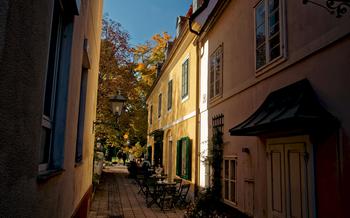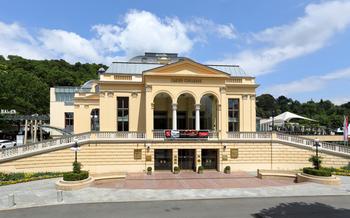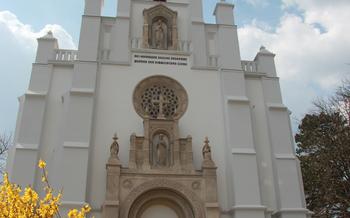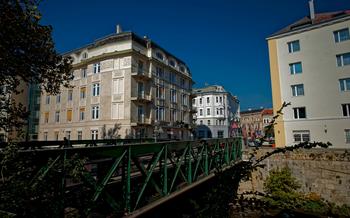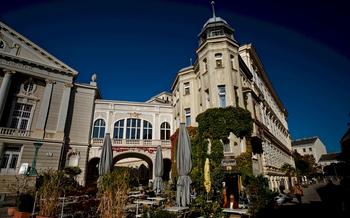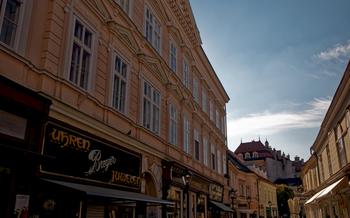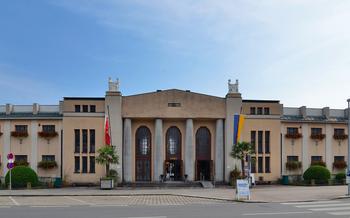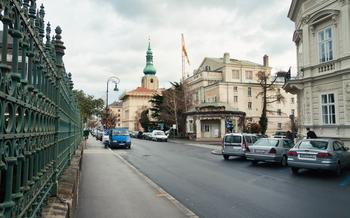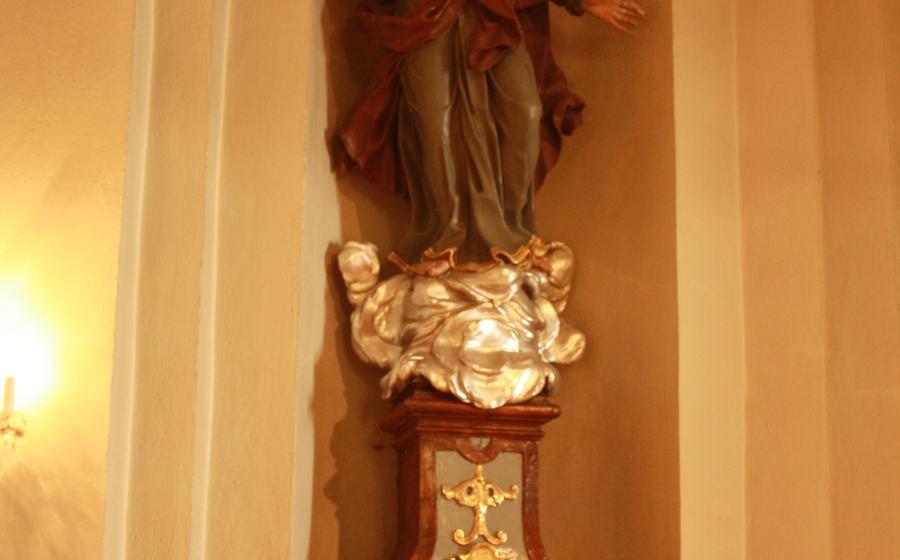
St. Helena's Church
- The Altar of St. Helena:
- Stained Glass Windows
- The Organ:
- The Crypts:
- Guided Tours:
- Pilgrimage Site
- Location and Accessibility:
- Opening Hours and Admission:
- Dress Code and Etiquette
- Places to Eat
- Souvenirs and Gifts
- Events and Festivals:
- Insider Tip: Unveiling the Secrets of St. Helena’s Church
The Altar of St. Helena:
The altar of St. Helena's Church is a masterpiece of Baroque art, crafted from exquisite materials such as marble, gold, and silver. Its intricate carvings and delicate ornamentation showcase the exceptional craftsmanship of the era. The centerpiece of the altar is a stunning depiction of St. Helena discovering the True Cross, a pivotal event in Christian history. The altar exudes an aura of grandeur and spirituality, symbolizing the deep devotion and artistry that went into its creation.
Legend has it that the altar possesses miraculous powers, particularly in granting wishes. Many pilgrims and visitors have sought solace and divine intervention by praying before the altar, offering their heartfelt petitions and hopes. Whether or not the legends hold true, the altar remains a testament to the enduring faith and devotion that have been nurtured within the walls of St. Helena's Church for centuries.
Stained Glass Windows
The interior of St. Helena's Church is further adorned by a series of magnificent stained glass windows. These exquisite works of art depict various biblical scenes and stories, adding a vibrant and colorful dimension to the sacred space. The windows, meticulously crafted by skilled artisans, showcase intricate designs and rich hues that bathe the church in a warm and ethereal light.
Each window tells a unique tale from the scriptures, inviting visitors to contemplate the events and teachings of the Bible. From the creation of the world to the life and ministry of Jesus Christ, the stained glass panels serve as a visual narrative, guiding the faithful through the history of salvation.
As the sun streams through the windows, the colors dance and shimmer, illuminating the interior of the church with a kaleidoscope of light. The play of light and shadow creates a captivating atmosphere that enhances the spiritual experience of visitors, inspiring a sense of awe and wonder.
These stained glass masterpieces are not just decorative elements but also powerful tools for catechesis and devotion. They serve as a reminder of the divine and invite contemplation on the mysteries of faith. The beauty and craftsmanship of the windows reflect the deep reverence and artistry that went into their creation, making them a treasured part of the church's heritage.
The Organ:
St. Helena's Church is home to a magnificent organ that holds a significant place in the church's history and musical traditions. Constructed by the renowned Rieger Orgelbau company in 1905, this grand instrument boasts 2,238 pipes, making it one of the largest organs in Austria. Its intricate design and imposing presence add to the awe-inspiring atmosphere of the church.
The organ's size and grandeur are not merely aesthetic features; they also contribute to its exceptional sound. The diverse range of stops and registers allows organists to produce a vast array of tones and textures, filling the church with rich and resonant melodies. Whether accompanying liturgical services or showcasing the talents of skilled musicians in concerts, the organ's music elevates the spiritual experience and leaves a lasting impression on visitors.
Regular concerts and performances are held at St. Helena's Church, providing an opportunity for music enthusiasts and visitors alike to witness the organ's capabilities firsthand. These concerts feature both classical and contemporary pieces, showcasing the versatility and expressiveness of this remarkable instrument.
The Crypts:
Beneath the awe-inspiring grandeur of St. Helena's Church lies a hidden realm of history and reverence—the crypts. These subterranean chambers, accessible through a discreet entrance, offer a glimpse into the past and the lives of those who have left an indelible mark on the church's legacy.
While the exact number of individuals interred within the crypts remains uncertain, it is estimated that hundreds of people have found their final resting place here. Among them are notable figures from the church's history, including former priests, prominent members of the congregation, and individuals who have made significant contributions to the community.
The crypts are a testament to the rich history and traditions of St. Helena's Church. They provide a unique opportunity to pay respects to those who have shaped the church's journey and to reflect on the lives they lived. Visitors are invited to explore these sacred spaces with reverence and a sense of awe, honoring the memory of those who have gone before.
Guided Tours:
St. Helena's Church offers guided tours for visitors who wish to delve deeper into its history, architecture, and religious significance. These tours are led by knowledgeable guides who provide insightful commentary and anecdotes about the church's past and present. Visitors can choose from a variety of tour options, including standard tours in English and German, as well as specialized tours tailored to specific interests, such as art history or religious symbolism.
The standard tours typically last for about an hour and cover the main highlights of the church, including the altar, stained glass windows, organ, and crypts. Visitors will learn about the church's construction, its role in the local community, and the stories behind the artwork and artifacts it contains.
For those seeking a more in-depth experience, private tours can be arranged upon request. These tours allow visitors to customize their itinerary and explore specific aspects of the church in greater detail. Visitors can also request tours in other languages, subject to availability.
Reservations for guided tours are recommended, especially during peak tourist season. Visitors can book their tours online or by contacting the church directly.
Pilgrimage Site
St. Helena’s Church holds a significant place as a pilgrimage site, attracting devout Catholics from across the region and beyond. The church is dedicated to Saint Helena, the mother of Emperor Constantine, who is revered for her role in finding the True Cross. Pilgrims often visit the church to pay homage to Saint Helena and seek her intercession. Throughout the year, the church hosts various religious festivals and celebrations, including the Feast of St. Helena on August 18th. During these events, the church comes alive with processions, prayers, and special masses, creating a deeply spiritual and devotional atmosphere. The sense of community and shared faith among pilgrims is palpable, as they gather to honor Saint Helena and deepen their connection with the sacred.
Location and Accessibility:
St. Helena's Church stands in the heart of Baden bei Wien, a picturesque town known for its thermal springs and rich cultural heritage. The church's exact address is Pfarrplatz 1, 2500 Baden bei Wien, Austria. To reach the church, visitors can take advantage of the town's excellent public transportation network. The Baden train station is just a short walk from the church, offering convenient connections to Vienna and other regional destinations. Additionally, several bus lines stop nearby, providing easy access for those exploring the town by public transport. For those traveling by car, ample parking spaces are available in the vicinity of the church, ensuring a hassle-free visit.
Opening Hours and Admission:
The doors of St. Helena's Church are open to visitors throughout the week, offering ample opportunities to explore its sacred spaces. Regular opening hours typically extend from morning until evening, allowing you to choose a convenient time for your visit. On Sundays, the church observes special hours, accommodating the influx of worshippers and pilgrims. During these times, visitors may still enter the church, but with the understanding that ongoing religious services take precedence.
Admission to St. Helena's Church is generally free of charge, reflecting its commitment to welcoming all who seek spiritual enlightenment and historical appreciation. However, certain special events, exhibitions, or concerts may require a nominal admission fee. These fees are typically used to support the ongoing preservation and maintenance of the church, ensuring its legacy for future generations.
Dress Code and Etiquette
When visiting St. Helena's Church, it is important to dress appropriately out of respect for its sacred nature. Casual attire is generally acceptable, but revealing or overly casual clothing should be avoided. For men, a collared shirt and long pants are recommended, while women should opt for a skirt or dress that falls below the knee.
Within the church, visitors are expected to maintain a respectful demeanor. This includes refraining from loud conversations, using mobile phones, or engaging in disruptive behavior. Photography is permitted, but flash photography and the use of tripods are generally not allowed. Visitors are also encouraged to be mindful of the ongoing religious services and activities that may be taking place during their visit.
Places to Eat
After exploring the stunning St. Helena's Church, you might be looking for a place to refuel and enjoy a delicious meal. Luckily, the area surrounding the church offers a variety of dining options to suit every taste and budget.
For a quick bite or a refreshing drink, consider stopping by one of the cozy cafes located near the church. These cafes offer a range of light snacks, sandwiches, and pastries, as well as hot and cold beverages.
If you're looking for a more substantial meal, there are several restaurants within walking distance of the church. These restaurants serve a variety of cuisines, including traditional Austrian fare, international dishes, and vegetarian options.
When it comes to Austrian cuisine, be sure to try some of the local specialties, such as Wiener Schnitzel, Tafelspitz (boiled beef), or Sachertorte (chocolate cake). For a taste of international flavors, there are restaurants serving Italian, French, and Asian cuisine.
Whether you're looking for a casual lunch spot or a fine dining experience, you'll find plenty of options near St. Helena's Church. Be sure to explore the surrounding streets and discover the culinary delights that Baden bei Wien has to offer.
Souvenirs and Gifts
As you depart from the sacred grounds of St. Helena's Church, you may wish to take home a memento of your visit. Within the church premises, you'll find a gift shop stocked with an array of souvenirs and religious items. Here, you can purchase traditional rosaries, intricately crafted crosses, and statuettes of saints, each imbued with spiritual significance. For those seeking unique or handcrafted items, there are exquisite pieces of jewelry, pottery, and artwork inspired by the church's rich history and symbolism. Whether you're looking for a small token of remembrance or a cherished gift for a loved one, the gift shop at St. Helena's Church offers a treasure trove of meaningful and memorable items.
Events and Festivals:
St. Helena's Church is not just a place of worship but also a vibrant hub for cultural and religious events throughout the year. One of the highlights is the annual Helena Fest, held in August to honor the patron saint of the church. The festival features a grand procession, traditional music, and dance performances, as well as food stalls and family-friendly activities.
For music enthusiasts, the church regularly hosts organ concerts showcasing the talents of renowned organists. These concerts provide an opportunity to appreciate the magnificent sound of the historic organ while enjoying the beautiful acoustics of the church.
During the Christmas season, St. Helena's Church transforms into a magical winter wonderland. The church is adorned with festive decorations, and special services and concerts are held to celebrate the birth of Jesus Christ. The Christmas markets in Baden bei Wien also offer a delightful experience during this time.
For those interested in history and culture, the church occasionally organizes guided tours that delve deeper into the stories and significance of its various features, including the altar, crypts, and stained glass windows. These tours provide a unique opportunity to learn about the rich heritage of St. Helena's Church and its role in the community.
Insider Tip: Unveiling the Secrets of St. Helena’s Church
As you explore the magnificent St. Helena’s Church, keep an eye out for the intricate details and hidden gems that make this sacred space truly special. One such treasure is the “Weeping Madonna” statue, located in a side chapel. This poignant depiction of the Virgin Mary shedding tears is said to have miraculous powers and attracts many pilgrims seeking solace and divine intervention.
Another fascinating aspect of the church is the “Bone Chamber,” which is not open to the public but can be viewed through a glass window. This eerie chamber contains the bones of over 4,000 individuals, arranged in an orderly fashion. It serves as a reminder of the transience of life and the inevitability of death.
For a unique perspective, climb the narrow spiral staircase to the church tower. From this vantage point, you’ll be rewarded with breathtaking panoramic views of Baden bei Wien, the surrounding vineyards, and the distant hills. It’s a perfect spot to soak in the beauty of this historic town and reflect on the rich history of St. Helena’s Church.
